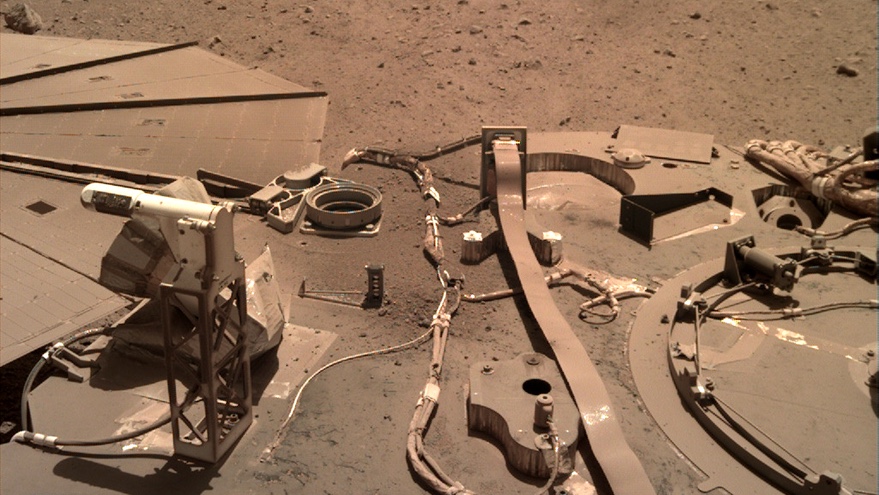WASHINGTON — Dust accumulation on the solar panels of NASA’s InSight Mars lander is reducing the power to the spacecraft and could force the mission to end within a year.
At a June 21 meeting of NASA’s Mars Exploration Program Analysis Group, Bruce Banerdt, principal investigator for the InSight mission at NASA’s Jet Propulsion Laboratory, said dust accumulating on the lander’s two solar panels has drastically reduced the amount of power they produce, requiring some instruments to be turned off at least temporarily.
“The dust accumulation on the solar arrays has been considerable. We have about 80% obscuration of the arrays,” he said. The amount of energy available to the lander per Martian day, or sol, has dropped from nearly 5,000 watt-hours shortly after its November 2018 landing to less than 700 watt-hours now, according to data Banerdt presented at the meeting.
The decline in energy was expected, and the mission was designed to have enough power for its prime mission, which lasted one Martian year or 687 days. The continued decline in power, though, is becoming an issue as InSight operates in an extended mission funded through the end of 2022 to collect additional seismic data.
Banerdt said the mission had hoped for “cleaning events” where winds remove some of the dust, allowing the panels to generate more power. Such cleaning events allowed the solar-powered Mars Exploration Rovers, Spirit and Opportunity, to operate for years, far longer than expected.
Those cleaning events have not taken place for InSight, though, and other attempts to remove the dust, such as shaking the panels, have failed. More recently, the mission tried a novel approach for cleaning the panels: using the lander’s robotic arm to scoop up regolith and then release it near the panels. Winds allowed some particles to bounce off the panels, in the process removing dust, a process known as saltation.
“We had some success with that,” he said. The first attempt at saltation increased energy output by 25 to 30 watt-hours, he said. A second attempt, though, provided only a temporary increase in energy, and a third attempt last weekend offered “a little bit of an increase.”
“This has bought us a little bit of headroom that we didn’t have before,” he said. Energy levels are dropping because of both the increased dust accumulation as well as Mars nearing aphelion, or the farthest point in its orbit from the sun. Mars will reach aphelion in about two months, after which sunlight, and thus power levels, should increase slightly.
Banerdt said the mission is closely monitoring power levels to determine what systems may need to be turned off as aphelion approaches. “It’s going to be extremely challenging to operate through that, especially with the instruments,” he said.
Some sensors, such as for collecting weather and magnetic field data, have already been turned off, or used only sporadically. “We hope to get some of these instruments up to at least do periodic measurements after aphelion,” he said.
InSight’s main instrument, a seismometer, has remained in operation. Banerdt, though, did not rule out having to turn it off near aphelion. “We may have to power off the entire payload for some period around aphelion,” he said. “There may be a month or two of time where we might have to turn off the seismometer, but we’re trying to tighten our belts and sharpen our pencils to see whether we can operate straight through.”
InSight will get a respite after aphelion as sunlight levels increase, but Banerdt warned it will be temporary. By April 2022, energy levels will decrease further, which he said was due to increased dust accumulation on the panels, more dust in the atmosphere and changes in orbital geometry. In a chart he showed, those power levels fell to the “survival energy” line below which the lander cannot operate.
“Unless we get a fairly significant increase in our solar array output, we’re likely to end our mission sometime around that time next year,” he said.
